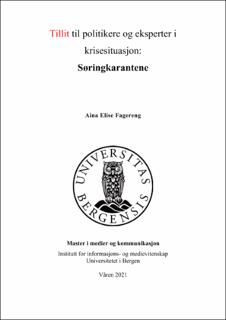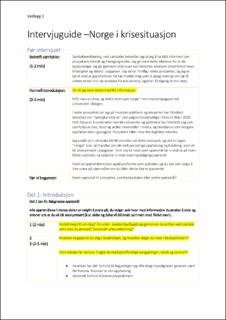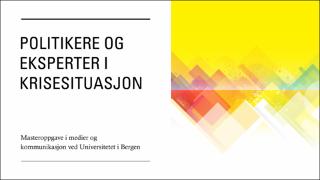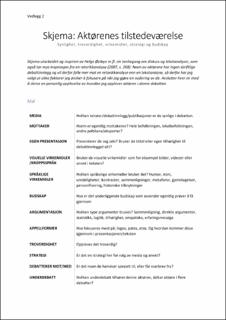| dc.contributor.author | Fagererng, Aina Elise | |
| dc.date.accessioned | 2021-08-04T23:53:37Z | |
| dc.date.available | 2021-08-04T23:53:37Z | |
| dc.date.issued | 2021-06-15 | |
| dc.date.submitted | 2021-08-04T22:00:08Z | |
| dc.identifier.uri | https://hdl.handle.net/11250/2766320 | |
| dc.description.abstract | Dette forskningsprosjektet tar for seg en av de største debattene som var i starten av Koronapandemien; Søringkarantene-debatten. Dette for å undersøke hvordan myndigheter, politikere og eksperter har håndtert situasjonen når de selv ikke vet sikkert hva som er rett å gjøre. Prosjektet starter med å gi en introduksjon i kapitel 1 om tematikken hvor tema blir presentert rundt utviklingen av pandemien og deretter hvordan debatten startet og fikk navnet «søringkarantene». Her presenteres motivasjonen for prosjektet, og hvilken interesseverdi dette har for forskning og samfunn. Og problemstillingene om (1) hvordan politikere og eksperter strategisk etablerer sin troverdighet knytt til saken, og (2) hvordan disse etableringen blir oppfattet av mottakerne, og de forskningsspørsmålene som kommer med. I kapitel 2 presenteres tidligere forskning på tillit i Nord-Norge, introduksjon i demokratiteori opp mot pandemi, og debattkultur. Og avsluttes med å presentere noen retoriske strategiske virkemidler og se på noen retoriske retningslinjer for retorisk arbeid som har som formål å gi begrepsforklaringer og kontekst til arbeidet. Utarbeidelse av metode og material-presentasjon kommer i kapitel 3. Her vil jeg framgangsmåten for bruk av metodetriangulering ved å kombinere tekst- og innholdsanalyse med kreative intervjuer. Dette er en debatt med flere perspektiver og kompleksitet, så det er mye som skulle kartlegges, i kapitel 4 presenteres overblikket av debatten og dens fire underdebatter; (1) den politiske debatten, (2) den helsefaglige debatten, (3) den juridiske debatten og (4) den personlige debatten. Dette for å gi et overblikk over materialet som er jobbet med, med fokus på de ekspertene og politikerne som har fått størst plass i den helhetlige debatten. Videre i kapitel 5 vil du kunne lese mer konkret om hver aktør i debatten, hvilken retorikk har de brukt og hvordan har dette blitt mottatt. Her vil det både siteres fra avsender og fra andre debattinnlegg for å vise konkrete eksempler for å forklare vurderingen av aktøren. Og i kapitel 6 presenteres andre perspektiver som kom frem i intervjurundene. Alle funn blir tilslutt drøftet i kapitel 7, dette for å summert og forklare konteskten opp mot alle funn i de tidligere kapitelene. Avslutningsvis kommer refleksjon av arbeidet og forslag til videre forskning. | |
| dc.description.abstract | This thesis is focusing on the debate that polarized Norway in a way I haven't seen in years. It all started as a political- and legal debate about the local quarantine-rules in the start of the first lockdown in the corona-pandemic, especially the one the northern counties in Norway introduced; roughly translated “south-quarantine”. The debate was punctual, strategic, and political in the start (13th of March), but went into different phases, and by April it had turned into a personal (and cultural) debate that polarized the people, expert and partly the government. Through a triangulation of three methods, I have investigated the debate to understand how (1) experts and politicians use rhetoric to create trust and ethos when discussing “south-quarantine” and (2) how does the public react to these strategies and arguments. To help me get some answers I have conducted a combination of qualitative- and quantitative research; to start off I did (1) a content analyses of 722 articles that I sorted and coded, before I continued with a (2) text/rhetorical analyses of the main text written by politicians or expert. To confirm my findings, I also conducted (3) a protocol inspired interview with 9 volunteers from the northern countries. The pattern in the debate shows how politicians and experts uses their arguments, title, and media as a tool in their strategy to gain trust. It seems that the local politicians try to speak to the citizens based on affiliation and experience as a person, while the Government only speaks trough their own channels. The debate started as a political matter, and the government situated in Oslo sent out a plead that the northern district should not keep up their local quarantine rules since a lot of workers couldn’t enter their workplaces. But the local politicians, together with local and regional health organizations, stood by their decision to keep up the local restrictions. I found that the entire debate could be split down into four meta-debates: (1) the political aspect, (2) the health- and infection control aspect, (3) the legal and economical aspect and (4) the personal aspect. All through the debate it was also discussed in the media if the debate was necessary or not, and a lot of different expert from different fields joined in on the written debate trough different platforms. And when the public had taken over the debate in April, there was no going back, and some politicians even tried to stop the debate from going further by blaming the media. The debates name, “søringkarantene”, became the biggest hit-word in Norway in 2020 and has become a word related to something negative and political. | |
| dc.language.iso | nob | |
| dc.publisher | The University of Bergen | |
| dc.rights | Copyright the Author. All rights reserved | |
| dc.subject | Debatt | |
| dc.subject | metodetriangulering | |
| dc.subject | politisk debatt | |
| dc.subject | tenkehøyt | |
| dc.subject | kvantitativ innholdsanalyse | |
| dc.subject | meningsytring | |
| dc.subject | retorikk | |
| dc.subject | kvalitativ tekstanalyse | |
| dc.subject | pandemi | |
| dc.title | Tillit til politikere og eksperter i krisesituasjon: Søringkarantene | |
| dc.title.alternative | Do we trust the government and experts in crises? Case: "Søringkarantene" | |
| dc.type | Master thesis | |
| dc.date.updated | 2021-08-04T22:00:08Z | |
| dc.rights.holder | Copyright the Author. All rights reserved | |
| dc.description.degree | Masteroppgave i medier og kommunikasjon | |
| dc.description.localcode | MEVI350 | |
| dc.description.localcode | MASV-MEVI | |
| dc.subject.nus | 735116 | |
| fs.subjectcode | MEVI350 | |
| fs.unitcode | 15-17-0 | |




